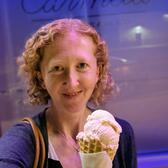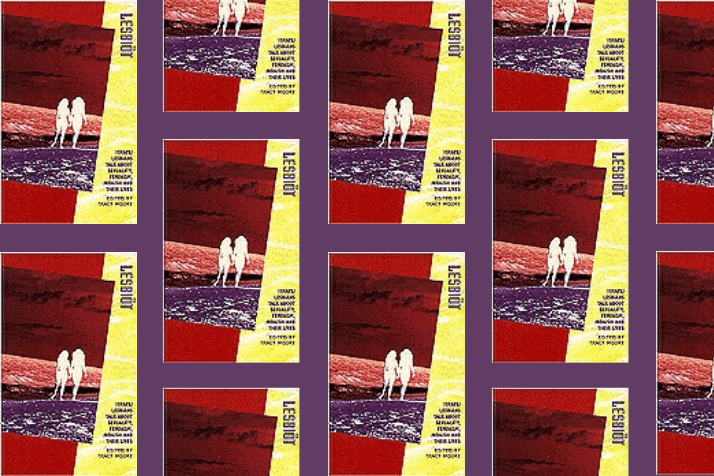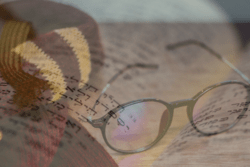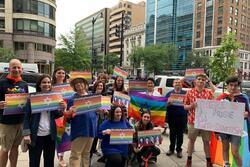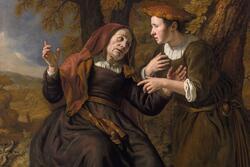"Lesbiot" Turns 25: Interview with Tracy Moore
JWA sat down with editor and activist Tracy Moore to discuss the 25th anniversary of Lesbiot, her 1995 collection of life stories by Israeli lesbians. While accompanying her partner, Lisa Edwards, to Israel for her first year of rabbinical school, Moore recorded 73 hours of interviews with 27 women between July 1988 and May 1989. In their narratives, the 21 women whose stories make up the collection, discussed five themes: family history; personal biography; lesbian sensibility and experience; Jewishness, Judaism, and Israel; and feminism and political issues.
How did this book project come to be?
I had been involved in lesbian publishing since the early 70s. From 1981 to 1988, I was part of a publishing collective of Common Lives/Lesbian Lives, a quarterly journal of lesbian writing and art that I co-founded. The day we arrived in Israel, one woman I had met through the magazine Lesbian Connection, said “Come stand with us at Women in Black [a women’s anti-war movement in Israel].” So the fourth day we were there, we went to the national protest movement of women dressed in black. They met every Friday in public places to protest the occupation. There, I started to meet all these great lesbians and found out from them that they had never done anything culturally qua lesbians like a newsletter or any kind of publishing, although they’d been political activists and socialized, too. I was interested in oral history from Common Lives/Lesbian Lives, and started asking them if they would be interested in interviewing with me on tape about their lives with the intention of publishing their stories. Since there wasn’t really anything written about lesbians, they were really interested in talking about their lives. I just started with the first people I met, and then they sent me to other people.
Can you walk me through what happened when you returned to the US?
I went home with a huge pile of tapes, and I needed to get them transcribed. I used all the ways that lesbians communicated and reached out through Lesbian Connection looking for volunteer transcribers. I got a great response from people, made copies of the tapes and sent them out. I got back floppy discs—remember them? Then I needed to have the narratives edited in order to publish them. I reached out to Israeli and American lesbian writers and editors for help. They each took one of the transcripts. After the 21 Israeli lesbians had a chance to make corrections, I thought they were all in great shape, but several publishers said “It’s too long, it’s too long.” And I said “No, you can’t leave that out.” But apparently you have to leave stuff out in order to get it published. England’s Cassell Press accepted the book and Lesbiot came out in '95, which was kind of a long time from when I was there, but it still managed to be the first book about Israeli lesbian life.
Can you talk a little about the political and historical situation in Israel at the time?
It was the beginning of the Intifada, but no one was being killed on buses yet. The peace movement and the pro-Palestinian movement were important. Israel was really secular at the time. If you go to Israel now, if you go to Jerusalem now, there are a lot of Haredim. To my friends who live there, it’s like their worlds have shrunk. The right wing is so strong. But back then, the left was strong, and the women’s movement, and the peace movement, and the pro-Palestinian movement were very strong.
The poet and activist Irena Klepfisz writes in her foreword of Lesbiot that some of the struggles and experiences of the Israeli lesbians would sound familiar to American lesbians, whether they are Jewish or not. I was wondering if that was true for you. Did you see some of your own experiences mirrored in the stories that the women told you?
Yes, for sure. All the regular things about discovering your lesbianism, whether or when to come out to your parents, the ways that lesbians make community that’s not necessarily public. In the political realm, 50 percent of the women there could be lesbians, but you’re all working on a different political goal or issue. They kept that separate. I had been out for a long time and had been very political—things were different in the US. We had so many lesbian publications! Book publishing companies, and magazines and newsletters—and they were available on the street where you could buy periodicals. Periodicals are what made movements happen.
You mention in your preface that one of the reasons you felt the women were comfortable talking to you was that you were an outsider. You weren’t Israeli, you weren’t even Jewish (yet).
Absolutely. I didn’t know anything! I didn’t know their culture, their history. I read a lot before we went because I was just so ignorant about Israel. But that’s not on-the-ground kind of knowledge, that’s up-in-the-air kind of knowledge. I kept my mouth shut a lot, and I absorbed everything that I could. People were so kind to me and tolerant. I think they were excited about having interest shown in their identities in a way that hadn’t happened before.
Can you talk a little about where your love for documenting women’s lives and lesbians’ lives originates? Are you still on the board of the ONE Archives Foundation?
I just stepped down after fifteen years! When I got into publishing, I realized that the stories of my peers were not available. That was what women were doing: coming forth with our understanding of the world, our analysis of politics, our analysis of how our upbringing and societal structures shaped us. The feminist groups I was involved with in the 60s had a lot of class differences. That was tremendously important for my consciousness-raising and my coming out. I grew up in the Midwest, in small towns—always kind of rebellious. A part of it was sexual, I’m sure... just wanting to be free. I was also pretty involved in anti-war activities. I went to New Zealand for six months as an exchange student when I was sixteen. That was one of the first things that made me more “worldly.” History comes from below. History is made by the people. But the spokespeople are often the ones that have privilege or are in power.
What do you think non-Jews and people who don’t identify as queer can take away from the book?
I think Lesbiot isn’t very much about Judaism. It’s more about Israeli culture, and politics, and national identification, and fighting for that identity. It’s probably of more interest to Jewish lesbians and maybe Jewish women. Like those publications we did in the 70s, it tries to capture the culture, and the gestalt, and the views. But I’m not sure what people can get from it. Maybe older lesbians or those interested in LGBT history would find it interesting. I regret that it has never been translated to Hebrew, so that it could be used referentially to know and learn something about women’s history in Israel.

